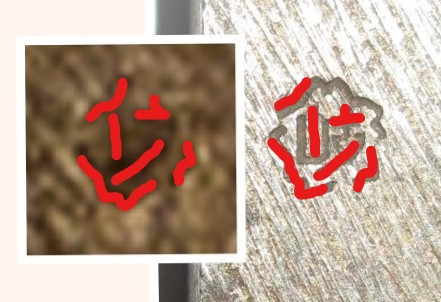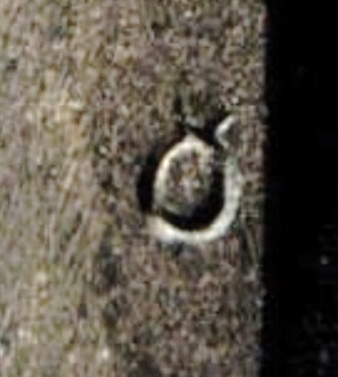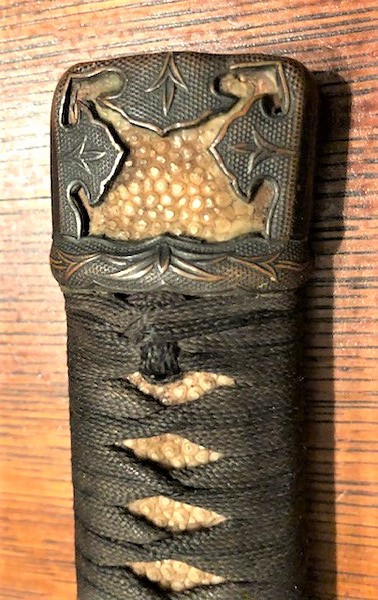-
Posts
13,514 -
Joined
-
Last visited
-
Days Won
161
Content Type
Profiles
Forums
Events
Store
Downloads
Gallery
Everything posted by Bruce Pennington
-
John, I'm with the other guys on this, in that it's most likely an older blade brought to the war. I my knowledge, arsenals didn't stamp older blades. "Hi" was used by the Mantetsu operation, but I don't know of an arsenal that used it. These marks are likely from the original smith. I have seen all sorts of marks on blade nakago mune of old blades, some pretty elaborate! I suspect your original thought about the top item being "Dai" is likely correct. The intent of the bottom mark is obscured enough by time and pock-marks that we may not be able to decipher it. Here's what I see as possible marks:
-
John, I admit, many inspector stamps are poorly struck, but with this mark, I can't see how it would be a "Na". Here's the Na:
-

Arsenal Mark on RJT sword Fittings
Bruce Pennington replied to george trotter's topic in Military Swords of Japan
This may be true, but it's a little messy with the Yamagami brothers, Akimitsu and Munetoshi being from Niigata. Their blades have the circled Matsu and are dated from Feb '42 (松 542) with 2 blades earlier (no dates available, but likely Aug/Sep '41). My earliest Nagano blades are dated Feb '43. As Niigata sits geographically right on top of Nagano, maybe the Army started the system with the Yamagami brothers in Niigata, as a trial, or the Nagano brothers invented the system, and the Army absconded with it (like they did with the Seki stamp!) and launched their use of it in Nagano? -
Hi, Like Jean said, please update your profile with a real first name. The blade is stamped with the "Gifu" stamp, which I believe was used by the Seki Cutlery Manufacturers Asssociation after the Nagoya Arsenal inpectors absconded with their Seki stamp. It signifies that the blade passed their inspection for quality. Currently, the source material is conflicting as to whether it signifies a non-traditionally made blade, so have to go by the blade, itself, for that determination. Non-traditionally made Rinji seishiki (type 3; type 100; type 44; etc), like you said are going for a variety of prices. A reasonable range is $900-1,200 USD. Start high and take offers!
-

WW2 Japanese sword (Fukumoto AMAHIDE)
Bruce Pennington replied to Swords's topic in General Nihonto Related Discussion
No one knows why some blades were hotstamped and some were not. As to this blade, I'm a REALLY bad guy to make such judgements, but I'd say it was at least oil-quenched by the dark areas inside the peaks of each 'tooth'. Clearly, a lot of quality workmanship by beauty of the blade, but probably non-traditionally made. -

need translation help on mei
Bruce Pennington replied to texanmarauder's topic in Translation Assistance
Hi John! These blades went through a lot from the war and the years after the war. Hard to know the causes of such stains. Your saya (scabbard) originally would have had a leather cover. They quite often are missing. You can find guys that do re-wraps for tsuka (handles) with a search on NMB. Any small stamps or numbers on the nakago (tang)? -

WW2 Japanese sword (Fukumoto AMAHIDE)
Bruce Pennington replied to Swords's topic in General Nihonto Related Discussion
Steve, The hotstamp is of his forge/shop. It is also found on blades of the other smiths that worked for him - Kanemune, Kunimoto, Hidetoshi, and Masafusa. It is a personalized variant of one used by the Shinshinto era Amahide (Masahide). Discussed on page 33 of the Stamps of the Japanese Sword document, and in Mal Cox's article Ichimonji Minamoto Amahide. As to the Mantetsu discussion, histories of the SMR operation tell that they invented a completely new process of sword making and used the Manchurian steel from their own mines. While anything else is possible, there is no actual evidence or documentation that backs up such speculation. -

Arsenal Mark on RJT sword Fittings
Bruce Pennington replied to george trotter's topic in Military Swords of Japan
Nagamitsu - So, since his numbers are on the mune, on non-star blades, and the kana don't match his prefecture, I'm thinking his numbering system is separate from the prefecture-based numbering of the other blades. Munehide - do you have a picture that shows the number and star? I cannot make either of them out from the yahoo photo. Edit: I see the serial number on the paper; but what about the star? -

Arsenal Mark on RJT sword Fittings
Bruce Pennington replied to george trotter's topic in Military Swords of Japan
Thanks for the new numbered blades Thomas. But now we have a problem. The only blades I've recorded so far with the "イ" are Nagamitsu blades. I had mistakenly recorded him as an Osaka smith, because previous discussions of him called him an Osaka Arsenal smith. But I see that he, Ichihara Nagamitsu, was from Okayama prefecture. Now, we have a "イ" numbered blade from a smith from Ibaraki prefecture! Okayama MIGHT have been under Osaka Arsenal control, but Ibaraki definitely was not. And in either case, the kana with numbers have been tied to specific prefectures up to now, not arsenals. Any idea what we are seeing here, or are we going to have to log these two down as currently "Unknown" as to why we now have 2 completely seperate prefectures using the same kana? Or, is it possible, @george trotter @mecox, that Nagamitsu worked for some time in the Ibaraki prefecture? PS: I must add that all 3 Nagamitsu numbers were on the nakago mune, not on the face of the nakago. This might mean that the Nagamitsu numbers were not prefecture specific? -
Can we get some opinions from our translators @SteveM @Kiipu @BANGBANGSAN ? Looks more like a "6 7" to me, but he horizontal stroke is missing if the second mark is a 7. The dai or Tai stamp I'm aware of has a hexagon around it. @John C - On most blades, the hash marks correspond to numbers stamped on the fittings. This would be Roman numeral "4", so does your blade come with fittings? If so, is there a "4" on the seppa and tsuba?
-

Emergency Issue ww2 Katana (Tang Stamp ID?)
Bruce Pennington replied to AlphaRaider's topic in Military Swords of Japan
Got a chance to meet Jonathan recently. A fine young man with a new appetite for Japanese swords! Let's all feed his burgeoning addiction! Ha! I also got the honor of examining this sword. It's not a fake. Nice weight to it. Visible yakote and suguha hamon. The mune of the blade tip has the standard flair-out (I think there's a word for that). Yet, the machi are slightly offset, like with see on Chinese fakes. So, I think this was made in China, during the occupation, either for a Japanese soldier, or for forces working with the Japanese. I know we discussed this on the previous thread, but I wanted to add my in-hand observations for the record. -
Chris, We are no longer certain the presence of the Showa and Seki stamps are signs of showato. So it is possible the blades are gendaito. As always, the blade must tell the story. Interesting note on the Kaneshige blades with Kobuse stamp - I have 5 on file now, and the 3 showing koshirae are all civil mounts! Interesting item!
-
Partially and poorly struck stamps can really play tricks on us. I know I've been down a couple of rabbit holes with some! Many of the Gifu stamps I have on file are really poorly struck. Seems symptomatic of their inspectors, for some reason. Here's how I see it:
-

Nagata Sukenori showa-to with no Seki stamp
Bruce Pennington replied to Yukihiro's topic in Military Swords of Japan
Thanks for the added photos, beautiful craftsmanship on that fuchi! Now I think there is a chance it is the same mark as on that blade I have on file. I think it's a shop logo. Guys can correct me if I'm wrong, but it's not a kanji that I've ever seen, so it's some sort of emblem, maybe intending to look like a fish? -

Nagata Sukenori showa-to with no Seki stamp
Bruce Pennington replied to Yukihiro's topic in Military Swords of Japan
That’s perfect thank you! Could be the same shop, or two different ones. They are slightly different and how they are crafted. -
Thanks Chris, I think it's a Gifu stamp. Adding it to the files!
-
Welcome, Lee! Looks like you're going about it the right way.
-

Nagata Sukenori showa-to with no Seki stamp
Bruce Pennington replied to Yukihiro's topic in Military Swords of Japan
Numbers, "2342". Don't know why they don't match the numbers on the fittings. Sometimes they do, sometimes they don't. Could I get a good, close shot of that stamp on the seppa? Haven't see that one before. It's very similar to an unknown stamp on a Yoshinao blade I have on file: -
I don't think so, Thomas. Incredible! Thanks for sharing!
-
Chris, Is that a Showa or Gifu stamp? and can I get a clear photo?
-
You're right! And those new photos show a better view of the tsuba, which looks the same. Just lower quality kabutogane, I guess.
-
Aliaksandr, There is a serial number on the back edge of the nakago. Can you please post a photo of that? An overall shot of the whole rig with fittings would be nice too! The key to decipher the zodiacal dates is here: http://japaneseswordindex.com/kanji/zodiac.htm, since we're doing the 'learning' thing! @Kiipu @BANGBANGSAN
-
I could be wrong, but this one looks like a fake imitation of the real one. Note the differences in the kabutogane in style and quality. Also, the wrap on this one is folded in one direction which is typical for Chinese fakes, and the material/color looks new. The fact that a faker would imitate the original means the original was legit WWII stuff. Fakers don't copy other fakes.













